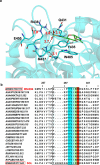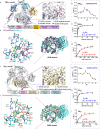Bioinformatics-Facilitated Identification of Novel Bacterial Sulfoglycosidases That Hydrolyze 6-Sulfo- N-acetylglucosamine
- PMID: 39712202
- PMCID: PMC11659886
- DOI: 10.1021/acsbiomedchemau.4c00088
Bioinformatics-Facilitated Identification of Novel Bacterial Sulfoglycosidases That Hydrolyze 6-Sulfo- N-acetylglucosamine
Abstract
Glycan sulfation is a widespread postglycosylation modification crucial for modulating biological functions including cellular adhesion, signaling, and bacterial colonization. 6-Sulfo-β-GlcNAcases are a class of enzyme that alters sulfation patterns. Such changes in sulfation patterns are linked to diseases such as bowel inflammation, colitis, and cancer. Despite their significance, 6-sulfo-β-GlcNAcases, which cleave β-linked 6-sulfo-N-acetylglucosamine (6S-GlcNAc), have been but rarely identified. This scarcity results mainly from the short, diverse, and distinctive sulfate-binding motifs required for recognition of the 6-sulfate group in 6S-GlcNAc in addition to the conserved GH20 family features. In this study, we discovered 6-sulfo-β-GlcNAcases and assigned two novel sulfate-binding motifs by the use of comparative genomics, structural predictions, and activity-based screening. Our findings expand the known microbiota capable of degrading sulfated glycans and add significant enzymes to the tool kit for analysis and synthesis of sulfated oligosaccharides.
© 2024 The Authors. Published by American Chemical Society.
Conflict of interest statement
The authors declare no competing financial interest.
Figures





Similar articles
-
Combining functional metagenomics and glycoanalytics to identify enzymes that facilitate structural characterization of sulfated N-glycans.Microb Cell Fact. 2021 Aug 21;20(1):162. doi: 10.1186/s12934-021-01652-w. Microb Cell Fact. 2021. PMID: 34419057 Free PMC article.
-
Sequential biosynthesis of sulfated and/or sialylated Lewis x determinants by transferases of the human bronchial mucosa.Glycobiology. 1999 Nov;9(11):1199-211. doi: 10.1093/glycob/9.11.1199. Glycobiology. 1999. PMID: 10536036
-
Biosynthesis of L-selectin ligands: sulfation of sialyl Lewis x-related oligosaccharides by a family of GlcNAc-6-sulfotransferases.Biochemistry. 2001 May 8;40(18):5382-91. doi: 10.1021/bi001750o. Biochemistry. 2001. PMID: 11331001
-
Enzymatic properties of β-N-acetylglucosaminidases.Appl Microbiol Biotechnol. 2018 Jan;102(1):93-103. doi: 10.1007/s00253-017-8624-7. Epub 2017 Nov 16. Appl Microbiol Biotechnol. 2018. PMID: 29143882 Review.
-
Roles of sulfated glycans in lymphocyte homing.Biol Pharm Bull. 2006 Dec;29(12):2343-9. doi: 10.1248/bpb.29.2343. Biol Pharm Bull. 2006. PMID: 17142960 Review.
References
LinkOut - more resources
Full Text Sources
Molecular Biology Databases
